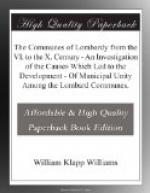[3:] Tacitus: Germania, cap. xvi.
[4:] The Sagas say the Lombards came originally from Scandinavia. Their name is commonly derived from “Long-beard,” but more probably came from words signifying “a long stretch of land.” Their first appearance in history is during the first century of the Christian era, in the region of Magdeburg. All trace of them is then lost till they reappear in the fifth century on the banks of the Oder; they then go south to the river Theiss. They are in a constant state of war with the Gepidae, a tribe nearly as fierce as themselves, which strife is supposed to have been fomented by the eastern emperors. In the year 567 the Lombards, under their king Alboin, together with the Avars, begin to move into Pannonia from Dacia and the region of the Don. Kunnemund, the king of the Gepidae, is killed, and his conquered people merged in the race of their conquerors. In the next year, still victorious, they overrun Northern Italy.
[5:] Some of these cities were enabled to hold out for a considerable period. Pavia was not taken till 572.
[6:] To these seaports some of the functionaries of the inland towns, especially among the clergy, were able to effect their escape. For instance, the Archbishop of Milan fled to Genoa, and the Archbishop of Aquileja to Venice.
[7:] The Christianity of the Lombards of the invasion was of the Arian form. Autari, who reigned from 584 to 591, married Theodolinda of Bavaria, and she first introduced orthodox Christianity. At the death of Autari she married Agiluf (591-615) duke of Turin, who was an Arian, but who pursued a mediative policy. During his reign a double ecclesiastical system, with orthodox and Arian bishops side by side, was maintained.
[8:] Justinian gave him the right to exercise, in reference to each city, the functions of the governor of the province, during the latter’s absence; and granted him jurisdiction in all cases not involving a larger sum than 300 aurei. He had a certain amount of authority in criminal matters, and two apparitors were attached to his person. The defensores had two guarantees for their power and their independence. 1. They had the right of passing over the various degrees in the public administration, and of carrying their complaints at once before the praetorian prefect; this freed them from the jurisdiction of the provincial authorities. 2. They were elected by the general body of the inhabitants of the municipium.
[9:] Paulus Diaconus: Lib. V., 7, 17, 18.
[10:] His words are: “Erano stati i Longobardi dugento ventidue anni in Italia, e di gia non ritenevano di forastieri altro che il nome.”—Nicolo Macchiavelli: Istorie Fiorentine, Lib. I. vid. Opere, Vol. III., p. 219 (ed. Milano, 1804).
[11:] It is difficult to draw any picture of the different ranks of society at this period, which would at once be perfectly accurate, and yet definite enough to give entire satisfaction to the student.




